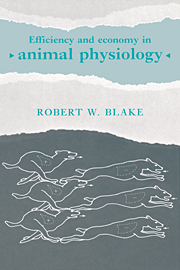Book contents
- Frontmatter
- Contents
- List of contributors
- Preface
- 1 Efficiency, effectiveness, perfection, optimization: their use in understanding vertebrate evolution
- 2 On the efficiency of energy transformations in cells and animals
- 3 Adapting skeletal muscle to be efficient
- 4 Efficiency and other criteria for evaluating the quality of structural biomaterials
- 5 Efficiency and optimization in the design of skeletal support systems
- 6 Efficiency in aquatic locomotion: limitations from single cells to animals
- 7 The concepts of efficiency and economy in land locomotion
- 8 Respiration in air breathing vertebrates: optimization and efficiency in design and function
- 9 Cardiac energetics and the design of vertebrate arterial systems
- 10 An evolutionary perspective on the concept of efficiency: how does function evolve?
- Index
4 - Efficiency and other criteria for evaluating the quality of structural biomaterials
Published online by Cambridge University Press: 03 October 2009
- Frontmatter
- Contents
- List of contributors
- Preface
- 1 Efficiency, effectiveness, perfection, optimization: their use in understanding vertebrate evolution
- 2 On the efficiency of energy transformations in cells and animals
- 3 Adapting skeletal muscle to be efficient
- 4 Efficiency and other criteria for evaluating the quality of structural biomaterials
- 5 Efficiency and optimization in the design of skeletal support systems
- 6 Efficiency in aquatic locomotion: limitations from single cells to animals
- 7 The concepts of efficiency and economy in land locomotion
- 8 Respiration in air breathing vertebrates: optimization and efficiency in design and function
- 9 Cardiac energetics and the design of vertebrate arterial systems
- 10 An evolutionary perspective on the concept of efficiency: how does function evolve?
- Index
Summary
INTRODUCTION
It is often assumed that the structural materials and mechanical devices found in animal skeletons represent perfect or near perfect solutions to the multitude of functional requirements that organisms encounter in their adaptation to ecological niches. That is, it is assumed that evolution has produced optimal designs in the construction of its skeletal systems. It is not clear, however, that this optimistic viewpoint is justified. Evolutionary biologists generally reject the concept of DESIGN as being ‘teleological’, because it implies that evolution is directed to a set of specific goals. Further, each structure and mechanism likely represent a compromise between a multitude of conflicting factors that together determine ecological fitness, rather than a clear optimum reflecting a single functional attribute. It is therefore reasonable to ask if design is a useful concept when considering the evolution of skeletal structures.
The word design has several meanings, and this is the cause of much confusion. Design as a noun is simply a statement of the relationship between the structure and the function of an object. For example, a bird or an aircraft wing has a shape that can be associated with its ability to generate aerodynamic lift with minimal drag, and this shape can then be regarded as a feature of the wing design. Alternately, the molecular and microscopic structure of collagen fibres can be correlated with the skeletal function of the tendons and ligaments that are fashioned from them. Again, the collagen fibre is a design because there appears to be a sensible relationship between structure and function. This definition of Design is relatively neutral because it does not imply quality or optimality in construction.
- Type
- Chapter
- Information
- Efficiency and Economy in Animal Physiology , pp. 43 - 64Publisher: Cambridge University PressPrint publication year: 1992



